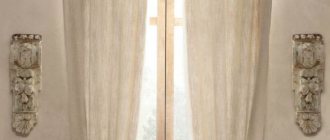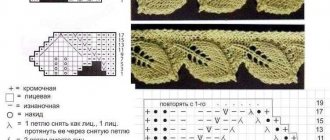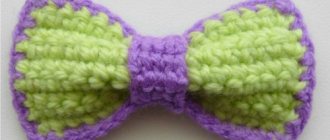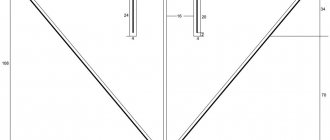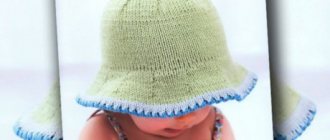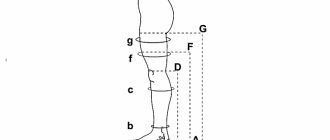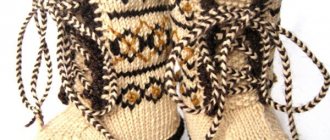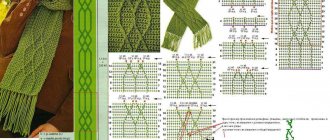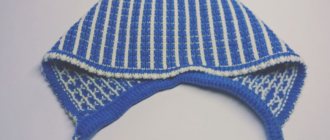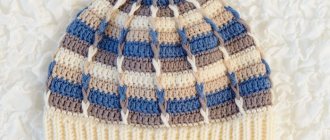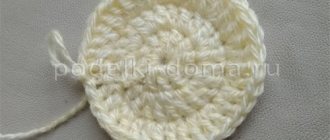A vest for a baby is a universal form of clothing that is very easy to knit even for beginner needlewomen. Today we’ll look at several options for knitting various sleeveless vests for every taste with detailed descriptions, so you can choose a vest that suits you.
Baby vest with button
The sleeveless vest with buttons is suitable for newborns and up to three months.
The vest size is 56/62 and the following materials and tools are required:
- yarn (acrylic);
- buttons – 1 pc.;
- knitting needles No. 3 and No. 3.5.
Now let's start knitting, starting with the back of a newborn's sleeveless vest.
- Use knitting needles to cast on 41 stitches.
- The elastic band is 1 knit x 1 purl to a length of 3 cm.
- Change needles to No. 3.5 and continue according to the following pattern: 5 purl stitches, 31 according to pattern No. 2 and 5 purl stitches. On the reverse side, purl outermost p. knitted in the same way, and the middle 31 - according to the pattern.
- After 11 cm from the cast-on edge, armholes begin, which are marked with a marker or a thread of a different color on both sides and knitted straight to a length of 20 cm.
- All loops are closed, marking 5 pcs in the middle. for the neck.
We knit the vest fronts.
- For the right front, cast on 26 stitches using size 3 needles.
- The elastic band is repeated (as on the back) up to a length of 3 cm.
- Close 5 pcs., change knitting needles to No. 3.5 and continue knitting in this way: 3 purl stitches, 13 according to pattern No. 2 and 5 purl stitches. On the reverse side, the outermost 3 and 5 go purl, and the central 13 according to the pattern.
- Having reached a total length of 11 cm, armholes are marked on both sides.
- After 20 cm from the start of knitting, 18 loops are closed from the shoulder side, and three are made with knitting needles another 2 cm.
- The left shelf is performed symmetrically.
Assembling the product:
- The shoulder seams are sewn along the marks and the side seams.
- For the neckline, a binding is made from fabric and sewn on.
- Mark the place for the hole for the button, this is about 1.5 cm from the cast-on edge.
- A hole is sewn in this place, and a button is sewn on the left front of the sleeveless vest.
The vest for the newborn is ready.
We are trying to make a warm vest and booties for a baby according to the scheme
The knitting pattern, as well as the pattern and symbols are presented below.
Vest and overalls for babies: Knitting pattern:
Decorative embroidery:
At the end of the master class, we present to your attention a video on knitting children's vests. Enjoy watching.
Vest with shoulder fastening
This baby vest, knitted with a relief pattern, has a fastener on the shoulder, so it is easy to put on your baby.
To work on a sleeveless vest, you will need the following materials:
- yarn;
- knitting needles No. 4.5;
- buttons – 2 pcs.
The first thing to start doing is the back of the baby's sleeveless vest.
- Use knitting needles to cast on 56 stitches.
- The purl stitch comes first.
- Then knit according to the pattern: edge, * 9 purl, 6 relief pattern, * between * * repeat, 9 purl, edge.
- The relief pattern is performed in this way: 1st, 3rd, 7th, 9th row, alternating 3 front and 3 purl; second and all even ones - purl only; 5th, 11th - remove 3 on an auxiliary needle before work, 3 p. and knitted with auxiliary knits. The result is a repeat of 12 lines in height, then repeats from the beginning.
- After 16 cm, armholes are formed; for this, two loops are reduced on each side, and another one every other row.
- At a product length of 25 cm, 35 pieces are closed on the right, 15 (for the fastener) another 1.5 cm are knitted, then the process of making the element is completed.
The next step is to complete the front of the vest.
- 56 stitches are also cast on with knitting needles and the back is repeated to a length of 22 cm.
- Then the neck begins, for which the central 6 pieces are closed. and the two parts continue separately.
- For a cutout along the inner edge, first 3 pieces are reduced on both sides through a stitch, then 2 and then 1 piece.
- Having passed 6 lines from the beginning of the neckline, holes for buttons are made on the left: hem, 1 according to the drawing, 2 knit stitches. together, yarn over, 7 according to pattern, k2. together, yarn over, 2 according to pattern. On the other side, the yarn overs are knitted purlwise.
- At a total height of 25 cm, knitting is completed.
All that remains is to assemble the sleeveless vest: sew the side and shoulder seams, sew on the buttons. After moistening and drying, the sleeveless vest for a newborn is ready.
Preparing for work
Yarn selection
Today, mommy has a wide selection of threads that can be used to create baby items.
Types of yarn
- Wool : Warm yarn can be pure wool , or blended fibers that are made by adding acrylic or viscose to wool threads are also suitable.
- Cotton : natural threads that provide warmth and comfort . Suitable for babies who have an allergic reaction to wool yarn. It exists both in pure form and mixed with viscose fibers.
- Synthetic materials: acrylic and viscose are also widely used in the manufacture of children's clothes.
Yarn requirements for children
Many manufacturers today produce threads designed specifically for knitting children's clothing . They are suitable not only for things of children of school and senior preschool age, but also for babies aged 1-2 years and newborns.
When choosing yarn, make sure it meets the following requirements .
- No allergic reactions . For work, you should choose only threads that do not cause irritation when in contact with the child’s skin. If the slightest irritation, redness, rash, etc. occurs when threads are applied to a small area of skin, you should stop using this yarn .
- Softness . In order for your baby to wear the new thing you knitted with pleasure, it should not be prickly, rough or even hard . Especially if you are preparing a little thing for a baby. In this case, you cannot do without soft and delicate yarn.
Tip : to make sure that the selected threads are suitable for the baby, apply them to the baby’s lips for a few moments. A negative reaction to the barbed thread will appear immediately.
- No lint. Another requirement is that the fibers must be smooth . If lint gets into the baby's mouth or nose, it can cause breathing problems.
Selection of knitting needles for work
Doing work with knitting needles is the most common type of needlework. A simple and reliable way is to do the work with the knitting needles indicated on the yarn label.
But this option is suitable when knitting from new threads. What if you took an existing ball, the label for which has already been lost?
In principle, anyone can do the job. Just keep in mind that the thicker the thread, the larger the diameter of the knitting needles.
And one more thing: medium or small thickness of tools is suitable for making thicker clothes, thick knitting needles are useful for creating an openwork little thing .
Product sizing
To knit a vest for a child, you will need to clarify its dimensions .
- Chest, waist, hips.
- Back length to waist line.
- Baby's growth.
When choosing a model for knitting, you will notice that most often they are indicated taking into account one parameter - the height of children.
In this case , it will be useful to clarify in this table which measurements are taken into account in this product .
And if necessary, they can be adjusted.
Knitting a vest with buttons in front
This vest is sized for a child aged 6 to 9 months. The braid pattern is suitable for both boys and girls. And you can knit it quickly and easily.
To work you will need:
- cotton yarn;
- knitting needles No. 3;
- buttons – 5 pcs.
The back is done this way.
- Use knitting needles to cast on 89 stitches.
- A double elastic band is knitted 4 lines, for this half of the loops are cast on with a thread of a contrasting color: the first line is knitted with working thread 1 knit, yarn over, this pattern is repeated until the end; second - the yarn over is knitted with the front one, 1 is removed as a purl unknitted, thread before work, this is repeated until the end; the third and all the following - 1 knit, 1 is removed as a purl before work. When completed, the contrasting yarn unravels.
- Next 4 lines are knitted with an elastic band, 1 knit x 1 purl.
- Now a 7 cm pattern with braids begins: 7 purl, *12 braid pattern, 9 purl*, between * * repeats, 12 braid pattern, 7 purl. Braid pattern: four rows of faces; Row 5 – 3 on an additional knitting needle while working, 3 knit stitches, knit 3 knit stitches. from additional, 3 to auxiliary before work, 3 persons.p., 3 go with auxiliary persons.p. The first time five rows are knitted, then from the second to the fifth.
- Next, purl stitch with decreases: 20 stitches are decreased evenly once, after 17 cm to form a raglan on both sides, after the first two and before the last two, 1 pc is decreased every other row. 4 times.
- After 21 cm, the back is laid down.
For the right side of the baby's vest front:
- Cast on 48 stitches.
- Again, 4 rows of double and 1x1 elastic, with the first 3 loops going double all the time.
- Next 3 double, 5 regular 1x1, 12 braids, 9 purl stitches, 12 braids, 7 purl stitches.
- After 7 cm, everything except the first 8 pieces. (they continue according to the pattern), knit purl, at the same time 7 pcs are evenly decreased. every 17 cm for raglan according to the same principle as on the back, through a line one at a time 4 times.
- At a total height of 21 cm, knitting is put aside.
The left side of the front part is performed similarly to the right, only symmetrically.
Product assembly:
- The knitted elements of the sleeveless vest are sewn together at the sides.
- The resulting sleeves are decorated with a placket: 41 loops are raised and the first 8 lines of the vest are knitted with elastic bands.
- To decorate the neck, take 37 pieces. on the right side of the front, 41 from the right sleeve placket, 61 pcs. from the back, 41 left sleeve, 37 from the left front and knit: 3 double elastic bands, 5 regular 1x1, *12 braids, 9 purl stitches*, from * to * repeat, 12 braids, 5 regular 1x1, 3 double.
- In this case, every three lines, 2 pieces are decreased. in areas made from purl. 4 times (two together at the beginning and end of the section).
- The last crossing of the pattern is accompanied by a decrease of 4 pieces. in every braid.
- After 5 cm of the vest yoke, the first and last 12 loops are closed and 2 pcs are decreased every other row. on both sides 3 times.
- At a height of 7 cm of the yoke, the neck strap of the vest is knitted: 40 neck loops are cast on and 4 lines are knitted with a regular elastic band and 2 lines with a double one.
- That's it - the work is completed. The shoulder seams are sewn together and the buttons are sewn on. For the holes for them, the space in the strip web expands slightly.
The finished vest for a baby or toddler needs to be slightly moistened and dried.
Some tips
When knitting products for infants and newborns, some important points should be taken into account. Firstly, in children of the first year of life, the body proportions are uneven - the head is slightly larger in relation to the rest of the body, so the neckline should be quite wide and elastic.
If clothes are put on over the head and the collar fits tightly to the neck (especially in warm winter clothes), it is necessary to provide a fastener with buttons or snaps.
It should be taken into account that for bulky products made from thick yarn it is better to choose buttons, since they will not create additional thickness and interfere with the child. Buttons should also not be too large; a clasp near the shoulder will be very convenient.
We should also not forget that all small elements must be securely fastened, and the yarn used must contain a high percentage of natural fibers.
How to knit a vest for a newborn step by step using knitting needles in MK
For work you will need the following tools and materials:
- Gray yarn;
- Circular knitting needles 3 mm;
- Circular knitting needles 2.5 mm - for knitting elastic;
- Buttons - 4 pieces.
Garter stitch will be worked in straight and reverse rows using knit stitches.
We make the “Double Pattern” pattern according to the following principle: 1 row by knitting alternating 2 knit and 2 purl loops, 2 rows we knit with knit stitches over the knit stitches and purl loops over the purl loops, 3 rows we knit with purl loops over the knit stitches and knit loops over the purl loops, the 4th row is knitted along analogies 2 series.
To create the button holes, you need to bind off the knit stitches on the right placket. To make one buttonhole, you need to knit the second and third loops from the edge together and make 1 yarn over.
In order to form a triangular neckline and armholes, it is necessary to perform decreases using the “Double Pattern” pattern. It should be taken into account that decreases must be made from the front side. Decrease the placket and sleeves in front of the edge according to the following principle: when the last loop should be knit-2 instead of knit, when the last loop should be purl-2 together purl. We also decrease after the edge of the placket and the sleeve when the first loop should be a knit stitch, namely, we remove one loop as when knitting a knit stitch, then one knit loop and a broach, when the first loop should be a purl loop - 2 purl loops crossed together, that is, knitting is carried out in back wall of the loop.
Vest pattern for a newborn:
The front and back of the vest.
The front and back of the vest are knitted in straight and reverse rows on circular needles from the middle of the front.
First you need to cast on 148 stitches on 2.5 mm circular needles. We will knit the first row on the front side with 5 garter stitch stitches, that is, we will make a placket. The placket is knitted according to the following principle: alternate two knit stitches and two purl stitches until 7 stitches remain. We finish with 2 knit stitches and 5 garter stitch stitches, that is, with a placket. Next, we continue knitting with an elastic band by analogy with knitting a strap until the height of the part is 3 cm. The main thing at this point in the work is not to miss the formation of buttonholes, which was described above.
We switch to 3 mm circular knitting needles and knit in stockinette stitch, and knit the placket as before - in garter stitch.
Let's form the back of the vest. Cast on 46 stitches and make the “Double Pattern” pattern in garter stitch on both sides. At this moment, the formation of the edges of the sleeve will begin. During the knitting process, stitches will be decreased to form the vest's armholes. We decrease one loop every second row, that is, in each row from the front side. Then we will continue the “Double Pattern” pattern and knit the product with garter stitch until the product height is 24 cm. Now we will knit with garter stitch on all loops until the required length of the product is reached. Each shoulder will be knitted separately.
Vest stripes.
To form the left front of the vest, it is necessary to continue the “Double Pattern” pattern and garter stitch, while making decreases to form armholes as on the back and to form a triangular neckline. After the last decrease, there should be 10 stitches left on the needle. Next, we knit the product to the required length on all loops, namely up to 26 cm. Close the loops.
The right shelf is knitted similarly to the left one in a mirror image.
Pocket cut.
We will form the pocket cut as follows: we will return 16 loops to the knitting needles and knit an elastic band, namely, 2 front loops and 2 purl loops. We use garter stitch in our work. When the pocket opening is 2.5 cm, the loops need to be loosely closed with knit over knit and purl over purl. The pocket slit needs to be sewn. Sew the pocket opening to the cut. We will make the second pocket cut in the same way.
Assembling the vest.
In order for the vest to be assembled, you need to sew the shoulder seams. Don't forget about the buttons.
Let's look at a few more interesting patterns for knitting children's vests.
